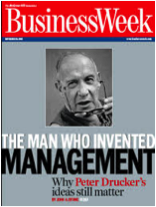Recently, I decided to reread Peter Drucker, the father of modern management. I first read Drucker many years ago and expected to find ideas that were woefully out of date. Instead, Drucker offered timeless wisdom about the role of the organization within society and the practice of management. The Essential Drucker published in 2001, is a wonderful abridged compendium of his life’s work.
In the chapter, “The Proper Use of Reports and Procedures” (excerpted from The Practice of Management), Drucker cautions about the misuse of reports and procedures as elements of oversight and control. Drucker wrote:
Reports and procedures are necessary tools. But few tools can be so easily misused, and few can do as much damage…There are three common misuses of reports and procedures. The first is the all too common belief that procedures are instruments of morality…The second misuse is to consider procedures a substitute for judgment…But the most common misuse of reports and procedures is as an instrument of control from above.
“The Agile Manifesto” affirms Drucker. In 2001, the authors of The Manifesto articulated the following principles as a path to better software development:
Individuals and interactions over Processes and tool
Working software over Comprehensive documentation
Customer collaboration over Contract negotiation
Responding to change over Following a plan
As project managers, we should consider Drucker’s wisdom and the principles of the Agile movement when deciding how to manage our projects.
Procedures are neither an instrument of morality nor are they a substitute for good judgment:
Contents
Procedures create the opportunity to establish consistent, repeatable processes, which is the basis for efficient project delivery. Imagine the chaos and waste if project managers did not have a set of standard practices or a common language. It would be like reinventing the wheel with each new endeavor.
Processes and procedures should not be treated as if they are moral code. The PMBOK® and similar standards provide a valuable lingua franca and framework for managing and executing projects. Following a methodology or framework is a best practice. However, strict adherence to codified procedures is not an imperative.
Procedures are not a substitute for good judgment. Good process does not make good software, good people do. A values based culture, where the team is empowered and expected to make the right decision, is more effective than one regimented to strict procedures. Nordstrom’s has famously created a value-based, customer-centric culture—return an item and enjoy the experience over a rules-based retailer.
Good process does not make good software, good people do
Agile software development principles embrace self-managed teams with limited process overhead. On agile projects, documentation is minimized because the goal is working software that meets customer needs. Within the scrum room, good judgment is valued over externally imposed procedures. In fact, the team is encouraged to create its own rules.
Reporting should be used to enable the project team rather than be used as a form of external control:
In many organizations, formal project reporting is primarily an instrument of management oversight and control. To be clear, the process of reviewing project status and metrics within the team is a critical component of organizing work and tracking progress. Transferring this information into PowerPoint status presentations or project management information system entries provides limited direct benefit to the project.
Project managers working in large organizations must balance what is required to execute the projects with the enterprise need to oversee its portfolio. At the project level, we should limit the reporting to what is minimally necessary to successfully complete the project. At the enterprise level, we should similarly strive to limit the oversight and control reporting to essential elements.
Drucker’s thoughts on reporting and control are at the heart of the Agile principles of simplicity, communication, and engagement. When integrated project teams work in a collaborative environment, the need for ‘control reporting’ is less because there is full transparency. Even in traditional waterfall projects, regular communication with all stakeholders reduces the need for oversight reporting.
In consulting on an Agile project, I noticed that the team conducted a series of weekly status meetings supported by a large, data intensive PowerPoint deck. In discussing this seeming contradiction, it was clear that while the organization was on the Agile path, they were not ready to fully relinquish the oversight and controls that were part of the broader enterprise culture.
Peter Drucker wrote The Practice of Management in 1955 at a time when command and control was the prevailing management practice. The project management profession should consider Drucker’s counsel on the misuse of procedures and reports. The allure of codified procedures and all-encompassing reporting is powerful because it provides a feeling of control and certainty. However, as the Agilests are demonstrating, lightweight procedures can yield better results.
“The Agile movement is not anti-methodology, in fact many of us want to restore credibility to the word methodology. We want to restore a balance.” Jim Highsmith
Sources:
Drucker, Peter F. The Essential Drucker: Selections from the Management Works of Peter F. Drucker. New York: Harper Business, 2001. Print.
Drucker, Peter F. The Practice of Management. New York: Harper & Row, 1954. Print.
“The Agile Manifesto.” Wikipedia. Wikimedia Foundation, n.d. Web. 27 May 2015. http://en.wikipedia.org/wiki/Agile_software_development#The_Agile_Manifesto
“Peter Drucker.” – Wikipedia, the Free Encyclopedia. N.p., n.d. Web. 27 May 2015. http://en.m.wikipedia.org/wiki/Peter_Drucker
Highsmith, Jim. “History: The Agile Manifesto.” History: The Agile Manifesto. N.p., 2001. Web. 30 May 2015. http://agilemanifesto.org/history.html
“Manage Uncertainty with Commander’s Intent.” Harvard Business Review. N.p., 03 Nov. 2010. Web. 29 May 2015. https://hbr.org/2010/11/dont-play-golf-in-a-football-g/
© 2015, Project Management Essentials, LLC
Image Courtesy of: https://www.Bloomberg.com and http://agilebacon.com/

